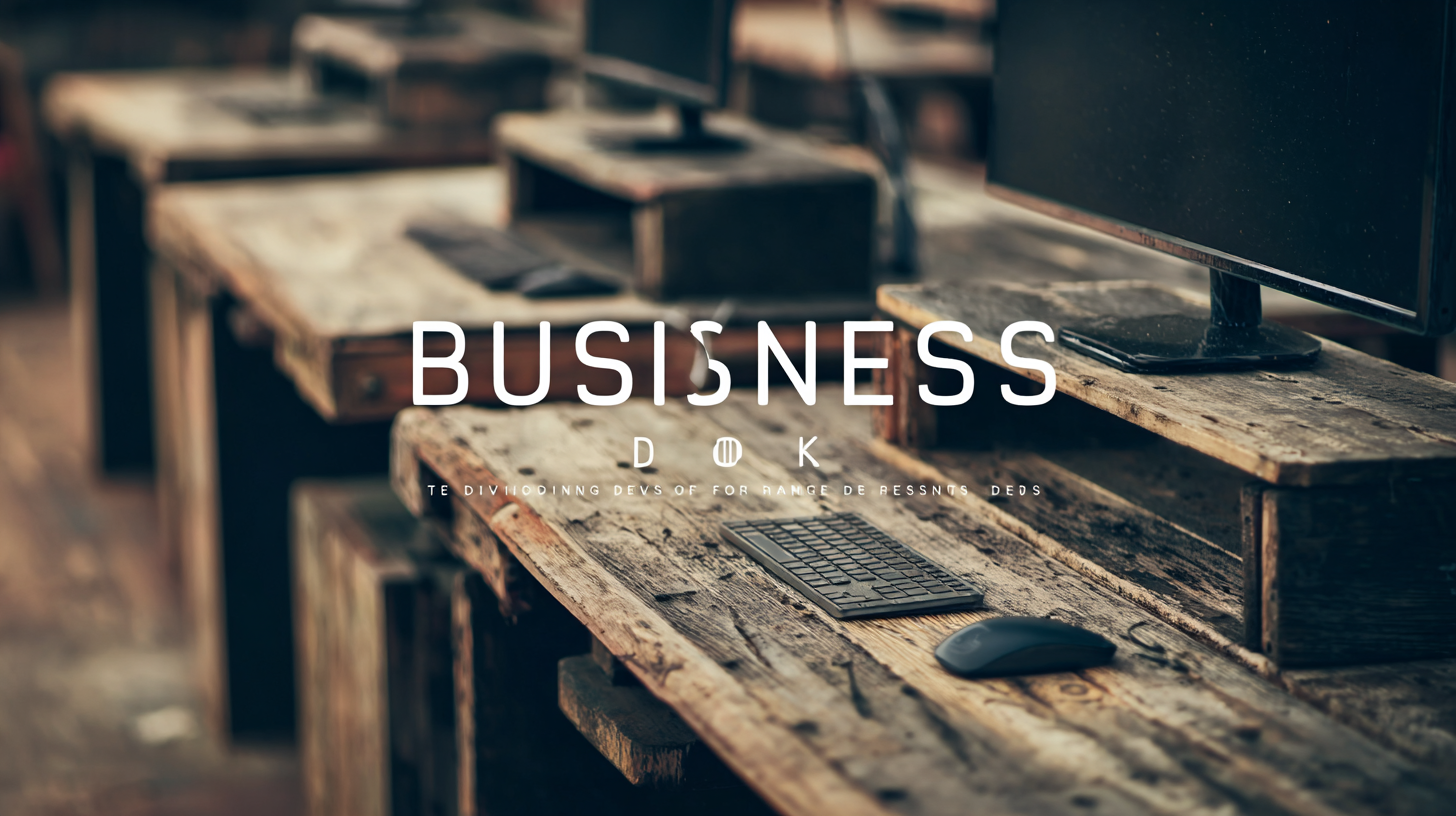Largest Selection of New and Used Office Furniture! Call 1-855-885-3375 or visit a showroom today!
Blog
Navigating the Future of Work Best Business Desks Redefining Productivity Through 2025 Technological Advancements
As we move towards 2025, the landscape of work is undergoing a fundamental transformation, heavily influenced by technological advancements and evolving workplace dynamics. A recent report by McKinsey highlights that 70% of organizations are re-evaluating their workspace design to enhance productivity and employee satisfaction. In this context, the role of business desks becomes increasingly crucial, serving not only as physical workspaces but also as strategic assets that foster collaboration, creativity, and efficiency. With the rise of remote and hybrid work models, selecting the right business desks that accommodate these changes is essential for maximizing output and ensuring ergonomic comfort. As companies pivot towards the future, investing in high-quality, adaptable business desks will be key to redefining productivity and achieving operational excellence in a fast-paced digital environment.

The Rise of Hybrid Work Models: Data-Driven Insights for Business Desks
The rise of hybrid work models has transformed traditional office settings, triggering a demand for business desks that align with new productivity paradigms. According to a recent report by McKinsey, 58% of employees now prefer a hybrid work arrangement, combining remote and in-office tasks. This shift has encouraged companies to rethink their workspace designs, prioritizing flexibility and employee comfort. The right business desk can significantly enhance productivity, allowing workers to customize their setup for optimal performance.

To keep up with this trend, businesses should invest in adjustable desks that cater to various work styles. Research from the Global Workspace Association indicates that standing desks can increase productivity by up to 46%, making them an attractive option for hybrid setups. Additionally, integrating technology solutions like charging ports and cable management systems can create a more seamless work environment, further boosting efficiency.
Tips: When selecting a business desk for hybrid work, consider ergonomics, as comfort plays a crucial role in employee wellbeing. Additionally, explore collaborative desk configurations that facilitate teamwork, even in a partially remote landscape. Lastly, regularly seek employee feedback on workspace preferences; this data-driven approach can guide future investments in office infrastructure.
Impact of AI and Automation on Office Productivity: Statistics You Need to Know
In today's rapidly evolving workplace, the integration of artificial intelligence (AI) and automation is redefining productivity. According to recent industry reports, businesses that adopt AI-driven solutions can increase operational efficiency by up to 40%. This technological shift not only streamlines repetitive tasks but also empowers employees to focus on higher-value activities, thereby enhancing overall workplace morale and job satisfaction. For example, organizations utilizing AI for data analysis can make decisions significantly faster, reducing decision-making time by almost 70%.

Furthermore, insights from various studies reveal that the adoption of intelligent automation can lead to a 30% decrease in operational costs, making it a critical component for businesses aiming to thrive in a competitive landscape. In the public sector, for instance, there has been a notable shift in attitudes toward AI, with over 60% of workers expressing optimism about AI's potential to enhance their productivity. By leveraging AI technologies, companies can uncover deeper insights through predictive analytics, ultimately fostering a culture of continuous improvement and innovation, vital for navigating the future of work.
Designing Ergonomic Workspaces: How to Enhance Employee Well-being and Output
Designing ergonomic workspaces is essential in today’s rapidly evolving work environment. According to a study by the Global Wellness Institute, companies that prioritize employee well-being see a 25% increase in productivity and a significant reduction in absenteeism. Elements such as adjustable desks, supportive seating, and proper lighting can create an environment that not only fosters comfort but also enhances overall performance.
Tip: Invest in adjustable desks. Research indicates that employees who use sit-stand desks report a 46% increase in productivity. Providing options for movement throughout the day can lead to better focus and creativity among team members.
Moreover, incorporating biophilic design, which integrates natural elements into the workspace, has been shown to improve mood and reduce stress. A report from Human Spaces reveals that workspaces with natural light and greenery can boost employee well-being by up to 15%.
Tip: Introduce plants strategically around the office. Studies suggest that even small amounts of greenery can enhance cognitive function, leading to more innovative ideas and effective teamwork. By focusing on these ergonomic principles, businesses can navigate the future of work with a healthier and more productive workforce.
Navigating the Future of Work: Best Business Desks Redefining Productivity Through 2025
| Desk Type | Adjustment Type | Key Features | Employee Rating (out of 5) | Impact on Productivity (%) |
|---|---|---|---|---|
| Height-Adjustable Desk | Electric | Multiple heights, Memory settings | 4.7 | 15 |
| Sit-Stand Desk | Manual | Simple adjustment, Compact design | 4.5 | 12 |
| Multi-Purpose Desk | Fixed | Versatile configuration, Storage options | 4.3 | 10 |
| Collaborative Desk | Fixed | Shared workspace, Integrated technology | 4.8 | 20 |
| Ergonomic Desk | Height-Adjustable | Curved design, Personalized features | 4.6 | 18 |
Future Trends in Office Furniture: Shifts Towards Sustainability and Technology Integration
As we navigate the evolving landscape of work, the office furniture industry is witnessing a profound transformation driven by sustainability and technological integration. Modern businesses recognize that the physical workspace not only influences employee productivity but also reflects their commitment to environmental responsibility. This shift towards sustainability is evident in the growing popularity of eco-friendly materials and the implementation of circular design principles, where products are designed with their lifecycle in mind. Companies are increasingly opting for desks made from recycled or sustainably sourced materials, reducing their carbon footprint while providing a healthier workspace.
Alongside sustainability, the integration of advanced technology into office furniture is revolutionizing how employees interact with their environment. Desks equipped with smart features, such as adjustable heights, integrated wireless charging, and built-in connectivity options, are becoming essential in promoting an adaptable work atmosphere. These technological advancements enhance productivity by allowing employees to customize their workspace according to their specific needs and preferences. As we look ahead to 2025, the fusion of technology and sustainable practices in office design will not only redefine productivity but also create a more engaged and motivated workforce.
Navigating the Future of Work: Trends in Office Furniture (2023-2025)
This chart illustrates the projected market share of key trends in office furniture from 2023 to 2025, emphasizing the shift towards sustainability and technology integration in work environments.
Measuring Productivity: Key Metrics for Evaluating Desk Efficiency in 2025
As we move towards 2025, the concept of productivity in the workplace is evolving.
One of the key areas to focus on is the efficiency of business desks, which serve as the central hub for creativity and collaboration.
Measuring productivity involves utilizing specific metrics that go beyond just hours worked or tasks completed.
In this new landscape, we need to consider factors such as ergonomic design, accessibility to technology,
and the spatial arrangement of desks that encourage teamwork while respecting individual work preferences.
To effectively evaluate desk efficiency, organizations should incorporate quantitative metrics like the time spent on collaborative tasks versus solitary work,
and qualitative feedback from employees about their comfort and concentration levels.
Data analytics tools can facilitate this process, helping businesses identify the best configurations that not only enhance individual productivity but also foster a more dynamic workplace culture.
By embracing these new metrics, companies will be better positioned to create environments that support their workforce and adapt to the fast-changing demands of the future of work.
